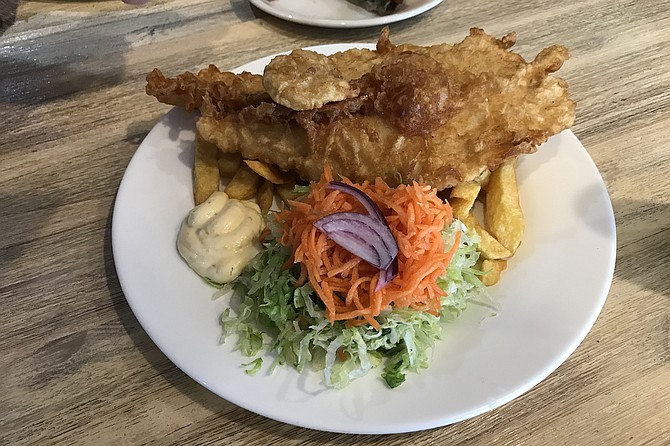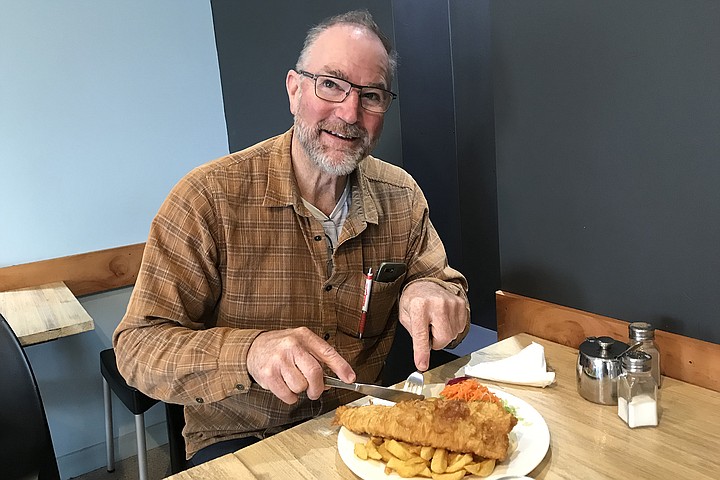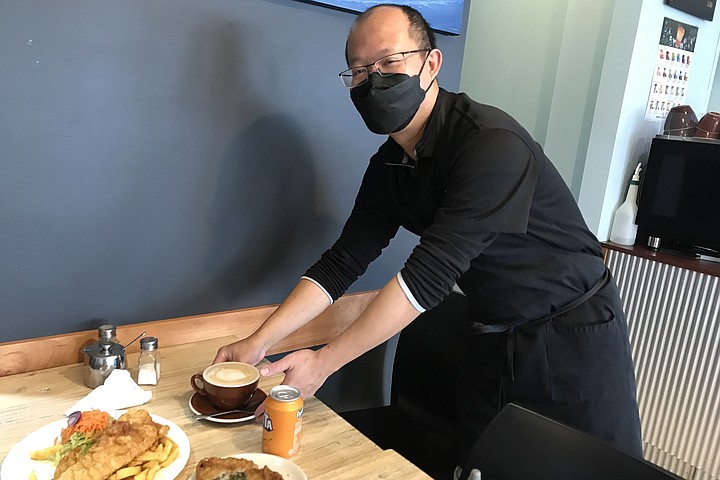 Facebook
Facebook
 X
X
 Instagram
Instagram
 TikTok
TikTok
 Youtube
Youtube

“New Season First Grade Bluff Oysters! Here we go, mate,” says Russell. “This is the one. This place is da bomb.”
We’re sitting beside a small sign: “Fed Up Restaurant & Takeaway,” here in Paraparaumu, a village on New Zealand’s North Island. (The name means “leftovers from the underground oven.”) Me, I’m here for a second week, visiting rellies.
“Kia Ora, mate.”
That’s Jerry, Fed Up’s owner, greeting us as we come in dripping out of the storm that’s raging outside. And hey, this is another thing that has changed since I was last here. The Māori language is on the march. It’s not so much “gidday” any more as “Kia Ora.” People don’t talk about “family” as much as “whanau.” They call their country “Aotearoa (Land of the Long White Cloud)” as much as “New Zealand.” Jerry himself is from Guangzhou, China. And he salts his talk with Māori words, too.

Biggest challenge? Remembering that everybody drives on the left. Dangerous when you’re stepping out on a crossroad. And yes, my Kiwi buddy Russell has hauled me out along Paraparaumu’s Marine Parade, right in front of angry waves crashing in from Australia (we’re in mid-Winter here). Says he wants to show me some real, Kiwi, tummy-warming fish and chips.
“Above all, mate, you’ve got to taste our real paua. Abalone. From the Chatham Islands.”
He says this is prime time for seafood. Oyster season is opening up, and nearby Antarctica is teeming with fish.
Why choose the Fed Up Cafe? It’s not just for the name. Russell says that Jerry, the guy who owns this place, has the best contacts with the fishermen out in the Chatham Islands. And everybody down here knows the Chatham Islands are what New Zealand used to be. Low on humans, high on fish. “And they have the best paua,” he says.
Boom! Clap of thunder right outside. Man. So good to be in out of that icy rain. One or two dripping people are ordering fish and chips to go. The back wall has the menu spread right along.

First thing you see is “Fresh fish, battered, $4.80.” (That’s around $3 in US currency.) Jerry says that Fed Up’s fish is pulled from Chatham water, out where the South Pacific the collides with the Southern Ocean. “They’re crazy fishermen out there,” says Russell. “That’s the difference. Jerry knows them all. Wines and dines them. Gets first dibs on their fish.”
Wow. It makes you think of Deadliest Catch, that 18-season reality show from up off Alaska.
So the choices are the basic fish around here, tarakihi (with the crazy official name, the jackass morwong), which is maybe the most New Zealand of fishes. Then there’s grouper (aka hapuku), and blue cod; those cost a bit more.
Says Russell, “Blue cod is my favorite, both ways: I mean, they’re actually cute fish. They get curious, if you dive round them. They’ll come up and nip your fingers. On the other hand, they are delicious to eat. Sort of salty, sweet, and really light. And it’s a fish you only find around New Zealand.”
“I have some in today,” says Jerry.
Huh. I keep scanning the menu. It’s huge, but in a way, it’s very simple: “fresh fish battered, $4.80; crumbed, $5; fresh fillet crumbed, $10.70.” Jerry says “fresh” means it’s been caught in the last few days, never frozen.
That’s it. Unless you make a meal of it and include fries (“chips”) and salad; then it shoots up to $16.50 (about $10.50 U.S.). Go for the blue cod meal and it’s a buck more. Go for the native sweet potatoes, kumera, and it’s $18.50 ($12).

“Bluff oysters?” Says Russell.
Oh yeah. Famous new season oysters from Bluff, the southernmost city on the New Zealand mainland. I pop out through the door just to check the chalkboard for the prices. Except the rains have washed the handwritten prices away.
“Four dollars each,” says Jerry. Wow. That’s about $2.50 in my money. But, new season and all, we have to try one battered one each.
“And, you know, we just about forgot,” says Russell. “Paua! Gotta have a paua fritter. Grow big as your hand out in the Chathams.”
Okay, ulp, menu says they’re $12 ($7.50) each. But I know from when I was a kid, levering those sucker-strong suckers off the rocks is never easy, even when you’re not in half-frozen waters. So we split it, and order one of them to share. I get a Fanta Orange can ($3.50), and Russell orders a Flat White (interesting coffee that New Zealand claims as its invention. They reckon it originated at a place called Bar Bodega, in the capital, Wellington, from a cappuccino gone flat).
Of course, then there is this huge list of other stuff. Doner kebabs (all about NZ$11), hot dogs (NZ$4) and burgers (NZ$8.50-$14.50). Whatever, for the two of us, dinner costs NZ$62.50 ($40). So not too bad. And, have to say, you get a lot. My chunk of fish is huge, and nice and crunchy, even after I soak it in vinegar. And it is so good, sitting here with competing bangs of thunder overhead and rain sheeting against the window like a Hollywood movie hose, downing all these bites of wickedly hot, salty, vinegary chips and fish.
Russell gives me a forkload of his blue cod. Hmm. I see what he means. It’s incredibly light flesh, a little sweet, a little salty. My battered Bluff oyster is fine, but maybe the most interesting is the abalone fritter, the paua. Maybe it’s the celery Jerry says he puts into the patty mix, but it has a dense-yet-tangy flavor that’s in no way spicy, yet qway refreshing.
“Of course, in Guangzhou, where I come from,” says Jerry, “they would do fish and shellfish like this paua a thousand ways. But there is a tradition here which I honor. I am a New Zealander now.”


“New Season First Grade Bluff Oysters! Here we go, mate,” says Russell. “This is the one. This place is da bomb.”
We’re sitting beside a small sign: “Fed Up Restaurant & Takeaway,” here in Paraparaumu, a village on New Zealand’s North Island. (The name means “leftovers from the underground oven.”) Me, I’m here for a second week, visiting rellies.
“Kia Ora, mate.”
That’s Jerry, Fed Up’s owner, greeting us as we come in dripping out of the storm that’s raging outside. And hey, this is another thing that has changed since I was last here. The Māori language is on the march. It’s not so much “gidday” any more as “Kia Ora.” People don’t talk about “family” as much as “whanau.” They call their country “Aotearoa (Land of the Long White Cloud)” as much as “New Zealand.” Jerry himself is from Guangzhou, China. And he salts his talk with Māori words, too.

Biggest challenge? Remembering that everybody drives on the left. Dangerous when you’re stepping out on a crossroad. And yes, my Kiwi buddy Russell has hauled me out along Paraparaumu’s Marine Parade, right in front of angry waves crashing in from Australia (we’re in mid-Winter here). Says he wants to show me some real, Kiwi, tummy-warming fish and chips.
“Above all, mate, you’ve got to taste our real paua. Abalone. From the Chatham Islands.”
He says this is prime time for seafood. Oyster season is opening up, and nearby Antarctica is teeming with fish.
Why choose the Fed Up Cafe? It’s not just for the name. Russell says that Jerry, the guy who owns this place, has the best contacts with the fishermen out in the Chatham Islands. And everybody down here knows the Chatham Islands are what New Zealand used to be. Low on humans, high on fish. “And they have the best paua,” he says.
Boom! Clap of thunder right outside. Man. So good to be in out of that icy rain. One or two dripping people are ordering fish and chips to go. The back wall has the menu spread right along.

First thing you see is “Fresh fish, battered, $4.80.” (That’s around $3 in US currency.) Jerry says that Fed Up’s fish is pulled from Chatham water, out where the South Pacific the collides with the Southern Ocean. “They’re crazy fishermen out there,” says Russell. “That’s the difference. Jerry knows them all. Wines and dines them. Gets first dibs on their fish.”
Wow. It makes you think of Deadliest Catch, that 18-season reality show from up off Alaska.
So the choices are the basic fish around here, tarakihi (with the crazy official name, the jackass morwong), which is maybe the most New Zealand of fishes. Then there’s grouper (aka hapuku), and blue cod; those cost a bit more.
Says Russell, “Blue cod is my favorite, both ways: I mean, they’re actually cute fish. They get curious, if you dive round them. They’ll come up and nip your fingers. On the other hand, they are delicious to eat. Sort of salty, sweet, and really light. And it’s a fish you only find around New Zealand.”
“I have some in today,” says Jerry.
Huh. I keep scanning the menu. It’s huge, but in a way, it’s very simple: “fresh fish battered, $4.80; crumbed, $5; fresh fillet crumbed, $10.70.” Jerry says “fresh” means it’s been caught in the last few days, never frozen.
That’s it. Unless you make a meal of it and include fries (“chips”) and salad; then it shoots up to $16.50 (about $10.50 U.S.). Go for the blue cod meal and it’s a buck more. Go for the native sweet potatoes, kumera, and it’s $18.50 ($12).

“Bluff oysters?” Says Russell.
Oh yeah. Famous new season oysters from Bluff, the southernmost city on the New Zealand mainland. I pop out through the door just to check the chalkboard for the prices. Except the rains have washed the handwritten prices away.
“Four dollars each,” says Jerry. Wow. That’s about $2.50 in my money. But, new season and all, we have to try one battered one each.
“And, you know, we just about forgot,” says Russell. “Paua! Gotta have a paua fritter. Grow big as your hand out in the Chathams.”
Okay, ulp, menu says they’re $12 ($7.50) each. But I know from when I was a kid, levering those sucker-strong suckers off the rocks is never easy, even when you’re not in half-frozen waters. So we split it, and order one of them to share. I get a Fanta Orange can ($3.50), and Russell orders a Flat White (interesting coffee that New Zealand claims as its invention. They reckon it originated at a place called Bar Bodega, in the capital, Wellington, from a cappuccino gone flat).
Of course, then there is this huge list of other stuff. Doner kebabs (all about NZ$11), hot dogs (NZ$4) and burgers (NZ$8.50-$14.50). Whatever, for the two of us, dinner costs NZ$62.50 ($40). So not too bad. And, have to say, you get a lot. My chunk of fish is huge, and nice and crunchy, even after I soak it in vinegar. And it is so good, sitting here with competing bangs of thunder overhead and rain sheeting against the window like a Hollywood movie hose, downing all these bites of wickedly hot, salty, vinegary chips and fish.
Russell gives me a forkload of his blue cod. Hmm. I see what he means. It’s incredibly light flesh, a little sweet, a little salty. My battered Bluff oyster is fine, but maybe the most interesting is the abalone fritter, the paua. Maybe it’s the celery Jerry says he puts into the patty mix, but it has a dense-yet-tangy flavor that’s in no way spicy, yet qway refreshing.
“Of course, in Guangzhou, where I come from,” says Jerry, “they would do fish and shellfish like this paua a thousand ways. But there is a tradition here which I honor. I am a New Zealander now.”